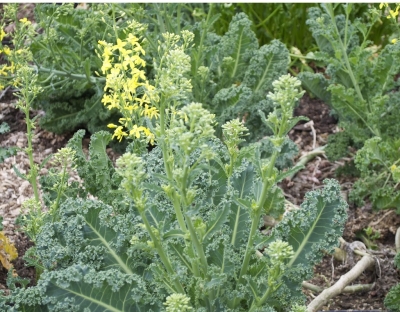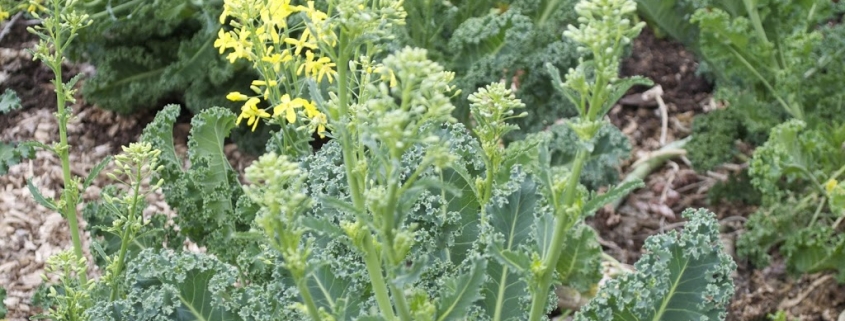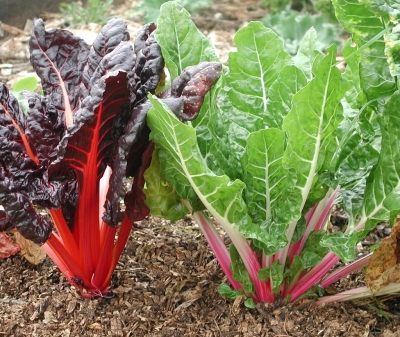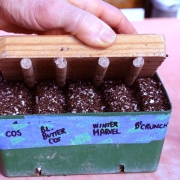The season’s first peas and potatoes are such a taste treat, radishes are fun, and everyone pines for the first tomatoes. But kale, I think, is the vegetable most worthy of praise. Here I am in the greenhouse, watering kale transplants for the garden even as, right behind me, kale in beds planted last August are still yielding mature leaves for salads and cooking.
Kale is one of the few vegetables that tolerates heat in summer, cold in winter, and every temperature in between. You can just keep picking the lower leaves as new ones keep growing up top. Neither broccoli, cauliflower, cabbage, nor other members of kale’s family can keep up production like that. And other greens, like lettuce, arugula, and mustard, send up seed-stalks and lose their flavor when days get long or hot. The kale in my greenhouse is now sending up seedstalks but the leaves taste as good as ever. Even the flower-heads themselves, which are like small, loose heads of broccoli, taste good.

Although one sowing, in early spring, could keep me in leafy greenery almost all year long, I do three sowings. The first, in early spring, is for planting out in a few weeks for eating from late spring on through summer. Sometimes, usually, I’ll sow again in July for even more greenery well into autumn and, depending on winter temperatures, into winter. The shorter plants of this later sowing are more apt to be covered by snow, which insulates the leaves and keeps them fresh all winter. In August I sow again for planting in the greenhouse, which gives us fresh kale until spring.
If I had to grow only one vegetable, kale might be the one. (I have a friend who does grow only one vegetable, and it is kale.) Besides its ease of growth and its longevity, kale packs a powerhouse of nutrients: vitamin C, vitamin K, calcium and all those other good things found in cabbage kin, and vitamin H (I made that last one up, but kale no doubt contains a lot of not-yet-known goodies also).
————————————————–
Seakale (Cramb maritima) is another “kale” I grow. This one might be good eating; I have yet to taste it even though I had it in the garden for over a decade. Besides being a different plant from kale, it is functionally different in that it has a short season of edibility, in early spring, and it is a true perennial, so potentially never needs replanting. Mine needs replanting this year because, for no apparent reason, it died last year.
Seakale is a salt-tolerant plant native to coastal regions of northern Europe, and it was in those regions that it was first moved into gardens for cultivation as a vegetable. Young shoots need to be blanched (grown in the dark) — by being covered with an upturned clay flowerpot, for example — to make them palatable. The blanched shoots are very tender, so you might never see them in markets. They should make a nice garden or farmden vegetable, though.
I have yet to taste seakale because each spring I’ve never got around to blanching it. Blanching can’t continue too long or the roots will be starved for energy, which comes from sunlight.
Seakale pulled its weight in my garden in other ways than putting food on the table. Its livened up one corner of the perennial flower bed with its silvery green leaves from which arose, in early summer, loose sprays of small, silvery white flowers, almost like the ocean spray in seakale’s native haunts. I never ate the plant because I didn’t want to weaken it and possibly tone down its spring and summer show.
I sowed new seed this week.
—————————————————-
Continuing the “kale” theme brings me to another vegetable, a close contender with kale for ease of
growth, longevity, flavor, hardiness, and nutrition. Seakale beet, as it is known in Britain; known as Swiss chard here. I plant chard just as I do kale, except less of it because it is less nutritious than kale (high oxalate concentration limits its availability of calcium), slightly less cold-hardy, and I happen not to like its flavor as much.
Seakale beet, or chard, is closely related to beet. In fact, both are the same genus and species. Chard is a beet with extra large leaves and an extra small storage root. But beets are another, story, an underground one.
—————————————————-









Haven’t tried this myself yet, but supposedly the unripe seeds of seakale are an excellent snack. Here’s hoping i can get some from the local beach before they all get plundered this year.
They probably are tasty. The unripe pods of radish — a relative of seakale — are tasty raw or pickled. Some varieties of radish are grown for their pods.
This is the 1st year for growing Kale – I have Russian & Dinosaur. Do you normally direct seed into the garden or start and transplant? I’ve started some seeds in my basement ‘greenhouse’ but nothing is germinating, anything special on them starting – temps, moisture, coverage, etc? Or did I maybe just get seeds with low germination rate? I got them from Landreth which I would think would test germination rates.
I usually start seeds in flats, then transplant out into the garden. Kale needs no special treatment from seed, just the usual well drained soil kept moist, but not sodden, with a little heat (about 70°) to get started, then cooler with bright light. Bury the seed about 1/4″. My guess is that the seed is fine, unless it’s very old.